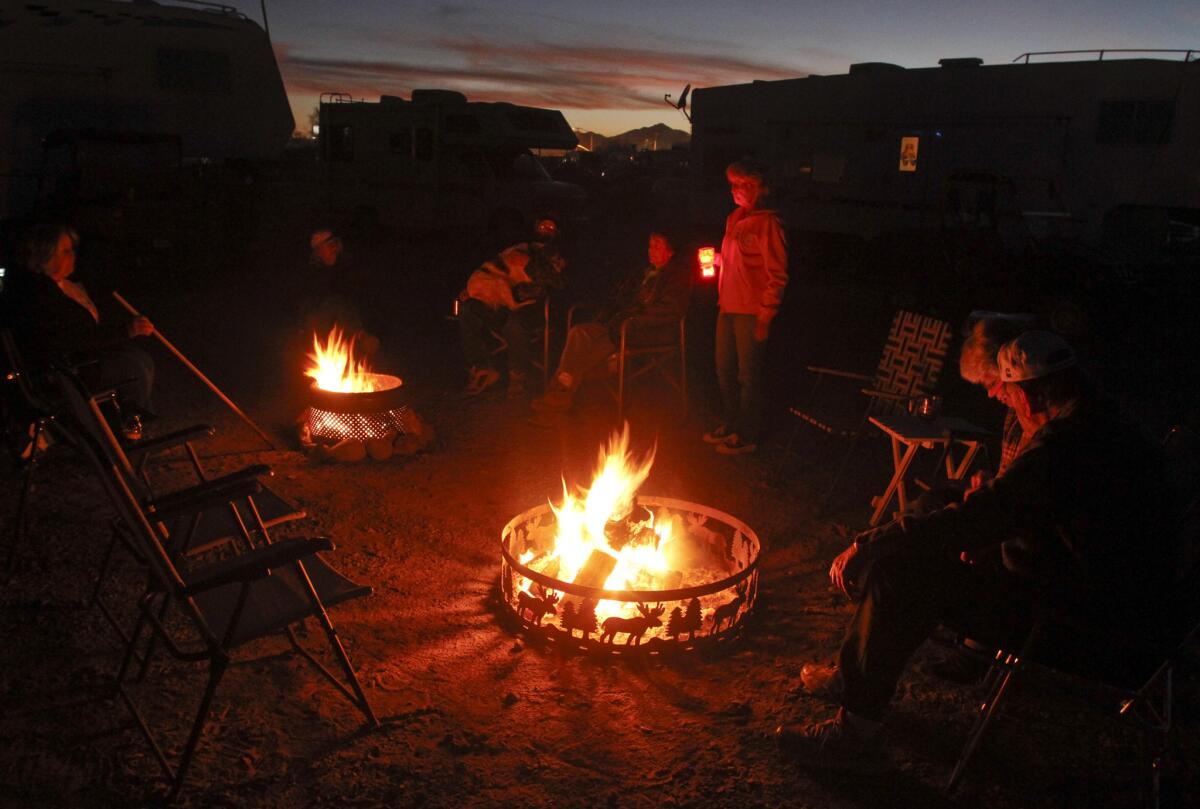Campfire stories may have sparked early societal learning

- Share via
Don’t underestimate the value of sitting around a campfire, listening to stories, singing songs and letting yourself stare mesmerized into the flickering flames. These activities may have played an essential role in early societies.
A new study suggests socializing and storytelling around a communal fire may have offered our hunting and gathering ancestors a unique time to expand their minds and imaginations in ways that were not possible during the hard work and harsh light of the daytime hours.
When humans first learned to control fire about 400,000 years ago, the quality of their lives changed dramatically. Brain size and gut size increased, predators no longer posed such a dire threat and our ancestors’ circadian rhythms shifted as firelight extended the day by several hours, according to the study.
The light of the fire interfered with melatonin production, allowing people to stay awake during a time when productive work was difficult to accomplish. Anthropologist Polly Wiessner wondered whether this newfound leisure time may have created a space for different types of social interactions as well.
In a paper published Monday in PNAS, she argues that conversations that take place at night around a fire have a different quality, and different content, than those that take place during the day.
“I think people are much more open at night by a fire,” said Wiessner, who teaches at the University of Utah. “We are always checking people’s facial expressions, but at night people are mostly staring into the fire and expressions are concealed.”
In 1974 Wiessner spent two months recording conversations between the Ju/’hoansi Bushmen, what was then a group of foragers in northeast Namibia and northwest Botswana in southwestern Africa. (Today they make only a small part of their living foraging.)
Wiessner originally made the recordings hoping to learn how this group of people established and maintained social networks across a vast area of 124 miles. But recently, she revisited the recordings to see how interactions among members of the community differed during the day and at night. She also returned to Namibia three times between 2011 and 2013 to digitally record stories from people she knew in the 1970s.
The conversations she collected were generally among at least four or five adults and lasted for 20 to 30 minutes. Of the 122 daytime conversations she recorded, 31% of them were devoted to economic discussions -- talk about foraging or hunting plans or technology. Thirty-four percent were devoted to criticisms, complaints and conflict, which was sometimes used to regulate social norms. Joking made up 16% of conversations in the daytime and stories made up just 6%.
At night, however, when the Ju/’hoansi Bushmen gathered around a fire, 81% of the conversation revolved around storytelling.
“During the day, the conversation was kind of nasty a lot of the time,” Wiessner said, “but at night they would mellow out and talk about the past. They would space travel and talk about group gatherings happening far away, they would cross time to their forefathers, and they traveled, in the stories, to other realms.”
From these stories, mostly about the adventures of known people, the multigenerational audience could glean information about the workings of their society, the rules of marriage and kinship, and learn regional traditions. Also, through hearing about the experiences of other people, the listeners gained empathy, Wiessner said.
Weissner doesn’t think that the lives of the Ju/’hoansi Bushmen foragers in the 1970s were the same as our early ancestors’, but she says the experiences of the Ju/’hoansi can help anthropologists form hypotheses about our hunter-gatherer ancestors who probably lived under similar conditions hundreds of thousands of years ago.
Next, Wiessner would like to examine how the red, orange and blue flames of firelight act on us physiologically by measuring how subjects’ hormone levels change when they relax and talk by the fire.
She hopes other researchers will contribute “ethnography of night” studies from different cultures. Another line of inquiry: How does the lack of firelight and storytelling time in our modern lives affect our society and our own individual sense of empathy?
After all, many of us are naturally drawn to fire, especially when we crave intimacy -- think candlelight dinners, romantic rooms with fireplaces, or making s’mores during a family camping trip.
Wiessner also notes that today, long after electricity reduced our time with actual firelight, our society’s nighttime hours are still often spent engaging with stories that we watch on television or read in books. But that seems to be changing.
“Like hunter-gatherers, we work our imaginations, gain new perspectives and expand our horizons from stories,” she writes in the paper. “Even so, artificial light and digital communication are invading the night worldwide, turning hours of darkness into economically productive time and overriding social time and story time.”
Science rules! Follow me @DeborahNetburn and “like” Los Angeles Times Science & Health on Facebook.







